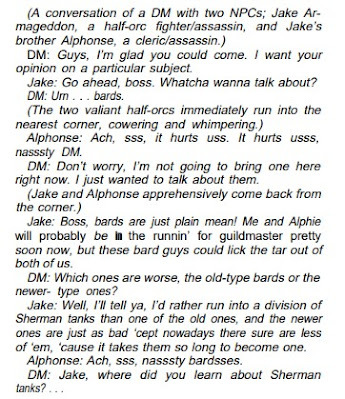The Articles of Dragon: "Singing a New Tune"
 In starting this new iteration of The Articles of Dragon, I struggled a bit with deciding when to begin. The very first issue of Dragon I remember buying for myself – from Waldenbooks, no less – was issue #62, which features a phenomenal cover painting by Larry Elmore. However, I'd been reading the magazine for a few months prior to that purchase, largely thanks my friend's older brother, who acted as one of our gaming mentors. He had a collection of Dragon issues and we'd often sneak into his basement bedroom to read them when he was out of the house.
In starting this new iteration of The Articles of Dragon, I struggled a bit with deciding when to begin. The very first issue of Dragon I remember buying for myself – from Waldenbooks, no less – was issue #62, which features a phenomenal cover painting by Larry Elmore. However, I'd been reading the magazine for a few months prior to that purchase, largely thanks my friend's older brother, who acted as one of our gaming mentors. He had a collection of Dragon issues and we'd often sneak into his basement bedroom to read them when he was out of the house. Issue #56 (December 1981), with its memorable Phil Foglio cover, was among the issues in that collection and is thus the first Dragon magazine I ever read. It's not a great issue, at least in comparison to many of those that followed, but it has two articles in it that I remember quite vividly, the first of which I decided would be the first entry in this new series, whose purpose, after all, is to use old Dragon articles as an occasion to share memories of my early days in the hobby.
Written by Jeff Goelz, "Singing a New Tune" offers up "a different bard, not quite so hard" for use with Advanced Dungeons & Dragons. AD&D's bard, as presented in the Players Handbook, is a bizarre and unprecedented multi-class/split class thing. A prospective bard begins play as a fighter. Then, after achieving a level between 5 and 7, he takes up thievery. He then abandons the thief class sometime between 5th and 9th level and becomes a bard proper. Why Gygax opted for this scheme is unclear, since Doug Schwegman's original bard class from Strategic Review, Vol. 2, issue 1 (September 1976) is a straightforward class without multiclassing. So different is this class than any other in the game that it's stuck in an appendix at the end of the PHB.
In his article, Goelz proposes to return bards to something closer to what was seen in the Strategic Review, albeit with numerous tweaks of his own. He begins with an amusing exchange between a DM and two half-orc NPCs, in which they discuss bards.
 I was so taken with this dialog that, all these years later, I can still quote sections of it from memory. The idea of a Dungeon Master chatting with two non-player characters, who call him "boss," is quite funny to me for some reason. The dialog also serves the purpose of pointing out the problems with both previous versions of the bard class.
I was so taken with this dialog that, all these years later, I can still quote sections of it from memory. The idea of a Dungeon Master chatting with two non-player characters, who call him "boss," is quite funny to me for some reason. The dialog also serves the purpose of pointing out the problems with both previous versions of the bard class.Goelz opted for a middle road between a wholesale rewriting of the class and a simple reworking of what had come before. He looked to the Welsh bard, both historical and mythical, for inspiration, using it as a guide for what aspects of previous bard classes to retain, to omit, or to alter. The result is, in my opinion, pretty good – simpler, more playable, and with a power level that's comparable to the other AD&D classes. Most importantly, Goelz's bard has a clear niche for itself as a loremaster with strong social skills and a smattering of druid and illusionist spells.
That list bit is important, because I think the real judge of whether the existence of a class is justified is its role within the game. Both previous versions of the bard were very broad classes with a wide range of skills and abilities that stepped on the toes of several other classes. This new one is much more unique, carving out a specific role that is not clearly served by any other class. That it's also mechanically less onerous is another point in its favor. That's why I was quite taken with it when I first read this article more than forty years ago.
At the same time, I've never been a huge fan of any version of the bard class. The bard has always felt weirdly specific – Goelz's version especially so – in much the same way that the monk did. In some campaign settings, a bard is perfectly reasonable and appropriate, while in others it would stick out like a sore thumb. My dislike is also probably a function of the people I've know who are boosters of the class: flamboyant, theatrical types with a penchant for extemporaneous poetry and song. I readily admit this is a me problem, not a bard problem as such, but it's there nonetheless. That's why I cannot recall the last time I've permitted a bard in any of my D&D campaigns. Were I to do so, however, I wouldn't hesitate to use the version in this article (or some variation thereof).

James Maliszewski's Blog
- James Maliszewski's profile
- 3 followers



